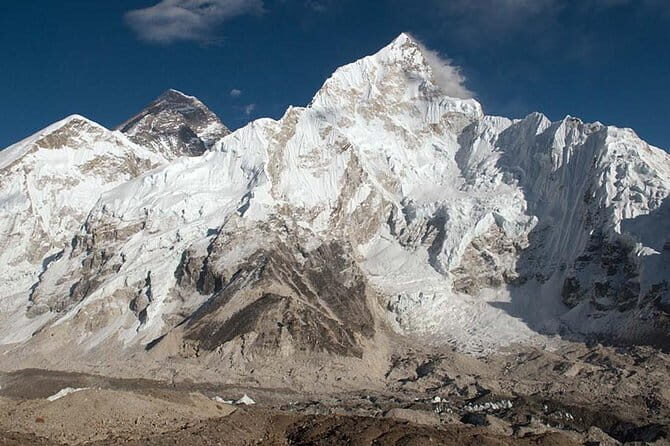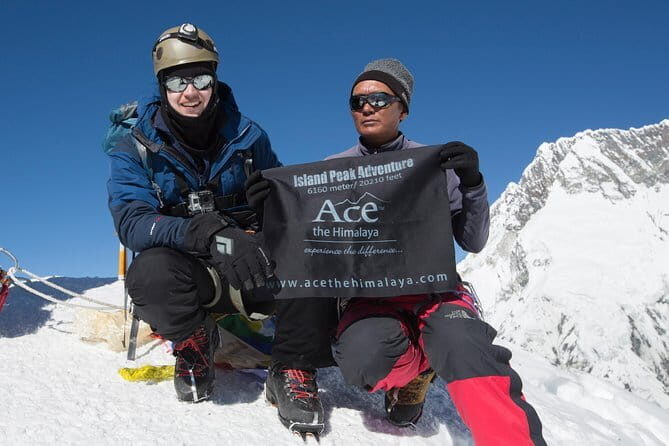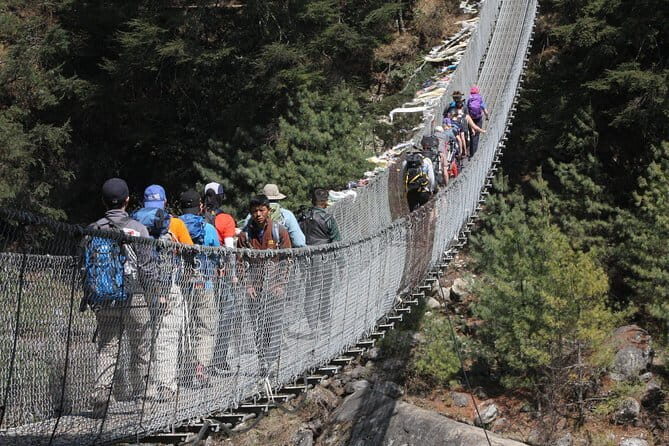Physical Address
304 North Cardinal St.
Dorchester Center, MA 02124
Physical Address
304 North Cardinal St.
Dorchester Center, MA 02124

Experience the breathtaking Himalayas on a 19-day Everest Base Camp trek with Island Peak climbing. All logistics handled, focused on active, adventurous travelers.
Travelers dreaming of standing at the foot of Everest or summiting one of the Himalayas’ most iconic peaks will find this 19-day tour from Ace the Himalaya a compelling option. It’s a carefully curated journey that combines the thrill of trekking to Everest’s base camp with the challenge of climbing Island Peak—one of Nepal’s most popular trekking peaks. The tour promises a comprehensive experience, with logistics managed for you, so you can focus on the adventure and the awe-inspiring scenery.
What we love about this tour is its well-structured itinerary, which thoughtfully includes acclimatization days to help prevent altitude sickness, and the opportunity for personalized attention on a small-group basis (max. 15 travelers). Plus, it offers a pre-trek sightseeing tour in Kathmandu, giving a cultural context to your Himalayan expedition. The full inclusion of accommodation, most meals, permits, domestic flights, guides, and porters makes it a smooth, stress-free way to witness Nepal’s iconic mountains.
One thing to consider is that this trek is physically demanding—best suited for fit and active travelers comfortable with high-altitude walking and climbing. It’s not for the casual tourist, but for those looking for a genuine challenge combined with the safety and support of experienced guides. If you’re seeking a well-supported but authentic Himalayan adventure, this tour addresses those needs brilliantly.


Looking for more options in Kathmandu? Here are some other experiences worth considering.
At $3,300 per person, this tour offers a significant amount of value, especially considering that all major logistics are covered. Accommodation in Kathmandu is in a three-star hotel, and during the trek, you’ll stay in comfortable guesthouses with attached toilets—a detail that makes a big difference after days of rugged walking. The inclusion of all necessary permits, park fees, and climbing gear further reduces hidden costs, making it easier for travelers to budget confidently.
Most meals are included during the trek, with fresh, local food served regularly, which reviewers consistently praise. The tour also provides a branded duffel bag and sunhat, adding a touch of professionalism and practicality.
Your adventure begins with a meet-and-greet at Tribhuvan International Airport, followed by a private transfer to your hotel. The initial day is flexible—if you arrive early, there’s a dedicated meeting to introduce your guide and answer questions, while late arrivals get a briefing on the next day’s plans.
Before heading into the mountains, the included Kathmandu sightseeing tour offers a cultural appetizer—visiting UNESCO World Heritage sites and getting a glimpse of Nepal’s vibrant capital. This light, enriching start helps balance the physical challenge ahead.
The highlight of the journey begins with a scenic 35-minute flight from Kathmandu to Lukla, often described as one of the most exhilarating parts of the trip. The tiny airport is famously dramatic, perched high on a mountain ledge, and sets the tone for the adventure.
From Lukla, the trek to Phakding is gentle, allowing your body to start adjusting and your mind to soak in the stunning landscape. You’ll cross suspension bridges decorated with prayer flags over the Dudh Kosi River, a view many reviewers say makes every step worthwhile. The walk is manageable and provides a good warm-up for the days ahead.
Crossing the river, the trail climbs into the Sagarmatha National Park, home to Everest. Namche Bazaar, the “Gateway to Everest,” is a lively hub filled with shops, internet cafes, bakeries, and vibrant markets. It’s the perfect stop for your first acclimatization day.
We loved the way guides emphasize gradual altitude gain. As one reviewer put it, “We will spend a day in Namche to acclimatize and avoid altitude sickness,” which is crucial in a trip of this magnitude. The breathtaking views of Everest and neighboring peaks from the Everest View Hotel are a highlight during this stay.
As you trek higher, Tengboche offers a spiritual and scenic highlight. The monastery, with its ornate murals and a large Buddha statue, is more than just a spiritual site—it’s also a vantage point for incredible mountain views. Attending a prayer ceremony, if timing allows, adds depth to the experience, as several reviewers mention being moved by the cultural richness.
Dingboche is a village that balances beauty with altitude challenges. It’s a strategic stop for further acclimatization, with options like a hike to Nangkartshang Peak, offering panoramic views of Ama Dablam—one of the most striking mountains in the area. Reviewers consistently mention how well the guides manage these acclimatization hikes, helping avoid altitude sickness.
The trek continues to Lobuche, located at the foot of towering peaks. Here, memorials for climbers lost on Everest remind trekkers of the mountain’s danger and majesty. Many travelers describe this as a profound part of the journey.
The ascent to Everest Base Camp is an emotional milestone, walking along the Khumbu Glacier with views of the Icefall and surrounding peaks. While it’s a physically demanding day, it’s considered a “bucket-list” moment—standing just below the world’s highest mountain.
Reviewers describe it as a “big and difficult day,” but also “spectacular,” with many saying it’s worth every step. After witnessing the expedition teams preparing for summit attempts, you truly feel part of Everest’s ongoing story.
Climbing Kala Patthar is often dubbed the most rewarding but toughest part of the trek. At 5,555 meters, it’s a steep climb, but the panoramic views of Everest and the surrounding giants make it an unforgettable highlight—something many travelers describe as the trip’s pinnacle.
One reviewer mentions, “The ascent is demanding, but the view of Everest is worth every breath.” The sunrise or sunset views from Kala Patthar are universally praised.
After reaching the high point at Kala Patthar, the journey continues with a trek to Chukhung and eventually to Island Peak (Imja Tse). The focus here shifts from trekking to mountaineering, with a dedicated two-day climb led by expert Sherpa guides.
According to reviews, climbers receive ice climbing training beforehand—covering ropes, crampons, and harnesses—making the ascent accessible even for those with limited technical experience. The climb itself isn’t technically difficult but requires stamina, willpower, and comfort at heights. Several reviews highlight the professionalism of guides like Pemba Sherpa, who are attentive and safety-conscious.
Weather in high mountains can be unpredictable. The itinerary wisely includes a spare day at Chukhung, allowing for summit attempts on Island Peak or rest if weather conditions aren’t favorable. Reviewers note that this flexibility is crucial for success and safety.
The descent takes you through lush forests and charming villages, retracing your steps with highlights like Tengboche and Namche. The final day of trekking ends in Lukla, where you can relax and reflect on your feat.
The return flight from Lukla to Kathmandu is often described as scenic—an emotional yet beautiful farewell to the mountains. Once back in Kathmandu, the trip wraps with a transfer to your hotel and options for exploring more of Nepal.
Throughout the tour, local licensed guides, climbing Sherpa experts, and porters make a noticeable difference. Multiple reviewers praise guides like Sandip, Deepak, Ram, and Pemba Sherpa for their knowledge, patience, and safety-conscious approach. You’ll be in good hands, especially during the climb up Island Peak, where the Sherpa team’s expertise is apparent.
From airport pickups to domestic flights, permits, and accommodations, everything is handled smoothly. The tour’s small size ensures personalized attention, and the group dynamic often enhances the camaraderie. The inclusion of all meals, water, and camp gear during the high-altitude camp stays removes much logistical stress, letting you focus on the experience.
This trek appeals most to fit, active travelers who are ready for a physically demanding adventure. If you enjoy challenging hikes, mountain scenery, and culture, you’ll find this tour a perfect fit. It’s also ideal for those who prefer a well-supported guided experience that simplifies planning and logistical worries. Because it includes a peak climb, it’s suited for climbers with a good fitness level and some willingness to learn mountaineering skills.
This Everest Base Camp and Island Peak tour offers a robust, well-rounded Himalayan experience. It combines the thrill of reaching Everest’s doorstep with the challenge of summiting a Himalayan peak, all supported by a professional team that cares about safety and comfort. With thoughtful planning, full logistical support, and the chance to connect with Nepal’s unique culture and stunning scenery, it’s a trip that promises memories to last a lifetime—especially for those who crave authentic adventure.

Is this tour suitable for beginners?
While the trek is physically demanding and includes high-altitude walking, it’s best suited for those who are fit and active. Climbing Island Peak requires some mountaineering awareness but is not technically difficult, thanks to pre-climb training.
Are all meals included?
Most meals during the trek are included, with a good variety of local and international dishes. Kathmandu hotel stays include breakfast only. Drinks such as alcohol, hot and cold beverages, are not included.
What is the main highlight of this tour?
Many say the highlight is reaching Everest Base Camp and witnessing the Khumbu Icefall, but climbing Kala Patthar offers the most spectacular mountain panorama, including views of Everest itself.
How does the tour manage altitude sickness?
The itinerary includes dedicated acclimatization days in Namche Bazaar and Dingboche, along with gradual elevation gain, which helps reduce risks. Guides monitor travelers closely and advise on acclimatization.
What kind of climbing gear is provided?
Group climbing equipment such as ropes, ice screws, snow bars, and ice hammers is provided. The guides will give ice climbing training upfront, making sure everyone is prepared.
Is this tour suitable for solo travelers?
Yes, as a small-group tour, it’s ideal for solo travelers who want companionship and guided support. You’ll be part of a maximum 15-member group.
What if the weather cancels the climb of Island Peak?
The itinerary allows a spare day at Chukhung for summit attempts. If weather conditions are poor, the climb can be postponed or canceled, and you’ll have the option to rest or explore elsewhere.
How do I prepare physically for this trip?
A good level of fitness is recommended, with some cardio and strength training before the trip. The treks involve long days of walking at high elevations, and the peak climb demands stamina and mental toughness.
In all, this tour offers an incredible Himalayan experience for adventurous, active travelers who want an organized, supported, and authentic trek to Everest’s doorstep with the thrill of summiting Island Peak.